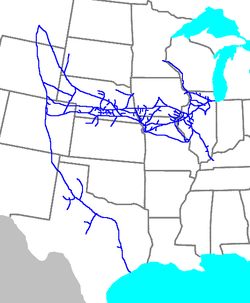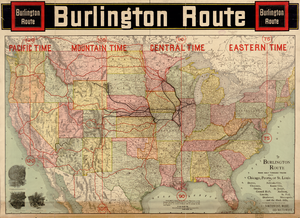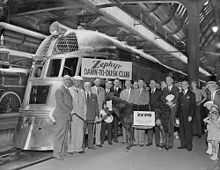- Chicago, Burlington and Quincy Railroad
-
Chicago, Burlington and Quincy Railroad 
The CBQ system map.Reporting mark CBQ Locale Colorado, Illinois, Iowa, Kentucky, Missouri, Montana, Nebraska, New Mexico, South Dakota, Texas, Wisconsin and Wyoming Dates of operation 1849–1970 Successor Burlington Northern (Now BNSF Railway) Track gauge 4 ft 8 1⁄2 in (1,435 mm) (standard gauge) Headquarters Chicago, Illinois The Chicago, Burlington and Quincy Railroad (reporting mark CBQ) was a railroad that operated in the Midwestern United States. Commonly referred to as the Burlington or as the Q, the Burlington Route served a large area, including extensive trackage in the states of Colorado, Illinois, Iowa, Kentucky, Missouri, Montana, Nebraska, Wisconsin, Wyoming, and also in New Mexico and Texas through subsidiaries Colorado and Southern Railway, Fort Worth and Denver Railway, and Burlington-Rock Island Railroad.[citation needed] Its primary connections included Chicago, Minneapolis-St. Paul, St. Louis, Kansas City and Denver. Because of this extensive trackage in the midwest and mountain states, the Q used the slogans "Everywhere West", "Way of the Zephyrs", and "The Way West".
Contents
History
1848–1882
The earliest forefather of the Chicago, Burlington and Quincy, the Aurora Branch Railroad, was chartered by act of the Illinois General Assembly on October 2, 1848.[citation needed] The charter was obtained by citizens of Aurora and Batavia, Illinois, who were concerned that the Galena and Chicago Union Railroad would bypass their towns in favor of West Chicago on its route; at the time, that was the only line running west from Chicago. The Aurora Branch was built from Aurora, through Batavia, to Turner Junction in what is now West Chicago. The line was built with old strap rail, and minimal, if any, grading. Using a leased locomotive and cars, the Aurora Branch ran passenger and freight trains from Aurora to Chicago via its own line from Aurora to Turner Junction and one of the G&CU's two tracks east from there to Chicago. The G&CU required the Aurora Branch to turn over 70 percent of their revenue per ton-mile handled on that railroad; as a result, in the mid 1850s, surveys were ordered to determine the best route for a railroad line to Chicago.
The line from Aurora to Chicago was built through the fledgling towns of Naperville, Lisle, Downers Grove, Hinsdale, Berwyn, and the west side of Chicago. It was opened in 1862, and passenger and freight service began. Regular commuter train service started in 1863 and remains operational to this day, making it the oldest surviving regular passenger service in Chicago. Both the original Chicago line, and to a much lesser extent, the old Aurora Branch right of way, are still in regular use today by the Q's descendant BNSF Railway.
With a steady acquisition of locomotives, cars, equipment, and trackage, the Burlington Route was able to enter the trade markets in 1862. From that year to date, the Burlington and its successors have paid dividends continuously, and never run into debt or defaulted on a loan—the only Class I U.S. railroad for which this is true.
After extensive trackwork was planned, the Aurora Branch changed its name to the Chicago and Aurora Railroad in June 1852,[1]and to Chicago, Burlington, and Quincy Railroad in 1856, and shortly reached its two other namesake cities, Burlington, Iowa and Quincy, Illinois. In 1868 the CB&Q completed bridges over the Mississippi River both at Burlington, Iowa, and Quincy, Illinois giving the railroad through connections with the Burlington and Missouri River Railroad (B&MR) in Iowa and the Hannibal & St. Joseph Railroad (H&StJ) in Missouri. The first Railway Post Office was inaugurated on the H&StJ to sort mail on the trains way across Missouri, passing the mail to the Pony Express upon reaching the Missouri River at St. Joseph, Missouri.
The B&MR continued building westward into Nebraska as a separate company, the Burlington & Missouri River Rail Road in Nebraska, founded in 1869. During the summer of 1870 it reached Lincoln, the newly designated capital of Nebraska and by 1872 it reached Kearney, Nebraska. That same year the B&MR across Iowa was absorbed by the CB&Q. By the time the Missouri River bridge at Plattsmouth, Nebraska was completed the B&MR in Nebraska was well on its way to the Mile High city of Denver, Colorado. That same year, the Nebraska B&MR was purchased by the CB&Q, which completed the line to Denver by 1882—the first direct rail line from Chicago to Denver.
1882–1901
Burlington's rapid expansion after the American Civil War was based upon sound financial management, dominated by John Murray Forbes of Boston and assisted by Charles Elliott Perkins. Perkins was a powerful administrator who eventually forged a system out of previously loosely-held affiliates, virtually tripling Burlington's size during his presidency from 1881 to 1901.
Ultimately, Perkins believed the Burlington must be included into a powerful transcontinental system. Though the Burlington reached as far west as Denver, Colorado, and Billings, Montana, it had failed to reach the Pacific Coast during the cheaper building years of the 1880s and 1890s. Though approached by E. H. Harriman of the Union Pacific Railroad, Perkins felt the Burlington was a more natural fit with James J. Hill's Great Northern Railway. With its river line to the Twin Cities, the Burlington formed a natural connection between Hill's home town (and headquarters) of St. Paul, Minnesota, and the all-important American railroad hub of Chicago. Moreover, Hill was willing to meet Perkins' $200-a-share asking price for the Burlington's stock. By 1900, Hill's Great Northern, in conjunction with the Northern Pacific Railway, held nearly 100 percent of the Burlington's stock.
In 1901 a rebuffed Harriman tried to gain an indirect influence over the Burlington by launching a stock raid on the Northern Pacific. Though Hill managed to fend off this attack on his nascent system, it led to the creation of the Northern Securities Company, and later, the Northern Securities Co. v. United States ruling by the U.S. Supreme Court.
1901–1945
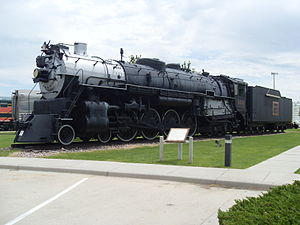 Chicago Burlington and Quincy Railroad steam locomotive build 1940 at West Burlington, Iowa, in service until 1956, on display since 1962 in Douglas, Wyoming
Chicago Burlington and Quincy Railroad steam locomotive build 1940 at West Burlington, Iowa, in service until 1956, on display since 1962 in Douglas, Wyoming
Following the purchase of the Burlington by the GN and NP, expansion continued. In 1908 the CB&Q purchased both the Colorado & Southern and Fort Worth & Denver Railways giving the Q extensive lines south to Dallas and the Gulf of Mexico ports in Houston and Galveston Texas.[citation needed] The Q also extended its reach south in the Mississippi Valley region by opening up a new line from Concord, Illinois south to Paducah, Kentucky. It was during this period that the Burlington was at its largest, exceeding just over 12,000 route miles in 14 states by the 1920s.[2] With the First World War having the same effect on the Burlington as on all other railroads, during the 1920s the Burlington Route had an increasingly heavy amount of equipment flooding the yards. With the advent of the Great Depression, the CB&Q held a good portion of this for scrap. Despite the decrease of passengers, it was during this time that the Q introduced the famed Zephyrs.
In 1929 the CB&Q created a subsidiary, the Burlington Transportation Company, to operate intercity buses in tandem with its railway network. In 1936 the company would become one of the founding members of the Trailways Transportation System, and still provides intercity service to this day as Burlington Trailways.[3][4]
As early as 1897, the Q had been interested in alternatives to steam power, namely, internal-combustion engines. The Aurora Shops had built a clumsy and totally unreliable three-horsepower distillate motor in that year, but it was hugely impractical (requiring a massive 6,000-pound flywheel) and had issues with overheating (even with the best metals of the day, its cylinder heads and liners would warp and melt in a matter of minutes) and was therefore impractical. Diesel engines of that era were obese, stationary monsters best suited for low-speed, continuous operation. None of that would do in a railroad locomotive; however, there was no diesel engine suitable for that purpose then.
Always innovating, the Q both purchased "doodlebug" gas-electric combine cars from Electro-Motive Corporation and built their own, sending them out to do the jobs of a steam locomotive and a single car. With good success in that field, and after having purchased and tried a pair of General Electric steeple-cab switchers powered by distillate engines, Q president Ralph Budd requested of the Winton Engine Company a light, powerful diesel engine that could stand the rigors of continuous, unattended daily service.
The experiences of developing these engines can be summed up shortly by General Motors Research vice-president Charles Kettering: "I do not recall any trouble with the dip stick." Ralph Budd, accused of gambling on diesel power, chirped that "I knew that the GM people were going to see the program through to the very end. Actually, I wasn't taking a gamble at all." The manifestation of this gamble was the eight-cylinder Winton 8-201A diesel, a creature no larger than a small Dumpster, that powered the Burlington Zephyr on its record run and opened the door for developing the long line of diesel engines that has powered Electro-Motive locomotives for the past seventy years.[5]
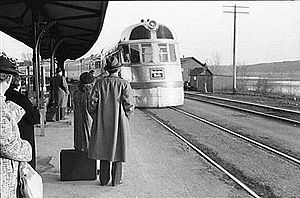 A Zephyr arriving at East Dubuque, Illinois
A Zephyr arriving at East Dubuque, Illinois
1945–1970
After the Second World War, the CB&Q was inundated by the overworked steam locomotives existent in a fleet that was already beginning to dieselize. Having expanded its dieselization program rapidly, steam power was slowly put out to pasture, and on September 28, 1959, the last steam-powered commuter train from Chicago rolled to a stop in Downers Grove, marking the end of the steam era on the CB&Q.
As the financial situation of American railroading continued to decline through the 1960s, the Burlington merged with the Great Northern Railway, Northern Pacific, and the Spokane, Portland and Seattle railroads on March 2, 1970 to form the Burlington Northern, a merger once dreamed of by Great Northern founder James J. Hill.[citation needed]
The Burlington Zephyrs
The railroad operated a number of streamlined passenger trains known as the Zephyrs which were one of the most famous and largest fleets of streamliners in the United States. The Burlington Zephyr, the first American diesel-electric powered streamlined passenger train, made its noted "dawn-to-dusk" run from Denver, Colorado, to Chicago, Illinois, on May 26, 1934. On November 11, 1934, the train was put into regularly scheduled service between Lincoln, Nebraska, and Kansas City, Missouri. Although the distinctive, articulated stainless steel trains were well known, and the railroad adopted the "Way of the Zephyrs" advertising slogan, they did not attract passengers back to the rails en masse, and the last one was retired from revenue service with the advent of Amtrak.
The Zephyr fleet included:
- Pioneer Zephyr (Lincoln–Omaha–Kansas City),
- Twin Cities Zephyr (Chicago–Minneapolis-St. Paul),
- Mark Twain Zephyr (St. Louis–Burlington),
- Denver Zephyr (Chicago–Denver),
- Nebraska Zephyr (Chicago–Lincoln),
- Sam Houston Zephyr (Houston–Dallas-Ft. Worth),
- Ozark State Zephyr (Kansas City–St. Louis),
- General Pershing Zephyr (Kansas City–St. Louis),
- Silver Streak Zephyr (Kansas City–Omaha–Lincoln),
- Ak-Sar-Ben Zephyr (Kansas City–Omaha–Lincoln),
- Zephyr Rocket (St. Louis–Burlington–Minneapolis-St. Paul), jointly with Rock Island
- Texas Zephyr (Denver–Dallas-Ft. Worth),
- American Royal Zephyr (Chicago–Kansas City),
- Kansas City Zephyr (Chicago–Kansas City),
- California Zephyr (Chicago–Oakland): Chicago–Denver handled by CB&Q; Denver–Salt Lake City by Denver and Rio Grande Western Railroad; Salt Lake City–Oakland by Western Pacific Railroad.
Other named passenger trains which operated on the Burlington included:[6]
- Aristocrat (Chicago–Denver): replaced the Colorado Limited.
- Ak-Sar-Ben (Chicago–Lincoln): replaced Nebraska Limited and replaced by Ak-Sar-Ben Zephyr.
- American Royal (Chicago–Kansas City): replaced by the American Royal Zephyr.
- Black Hawk (Chicago–Twin Cities overnight).
- Coloradoan (Chicago–Denver): replaced by the Aristocrat.
- Fast Mail (Chicago–Lincoln).
- Nebraska Limited (Chicago–Lincoln): replaced by the Ak-Sar-Ben.
- Exposition Flyer (Chicago–Oakland) in conjunction with D&RGW and WP prior to the launching of the California Zephyr.
- Empire Builder: handled Great Northern Railway's flagship between Chicago and Minneapolis.
- North Coast Limited: handled Northern Pacific Railway's flagship between Chicago and Minneapolis.
- Mainstreeter: handled the Northern Pacific Railway's secondary transcontinental between Chicago and Minneapolis.
- Western Star: handled the Great Northern Railway's secondary transcontinental between Chicago and Minneapolis.
The California Zephyr is still operated daily today by Amtrak as trains Five (westbound) and Six (eastbound). Another Amtrak train, the Illinois Zephyr, is a modern descendant of the Kansas City Zephyr and the American Royal Zephyr services.
Innovations
The Burlington was a leader in implementing technological innovation; among its firsts were use of the printing telegraph (1910), train radio communications (1915), streamlined passenger diesel power (1934) and vista-dome coaches (1945). In 1927, the Burlington was one of the first to utilize Centralized Traffic Control (CTC), and by the end of 1957 had equipped 1,500 miles (2,400 km) of its right-of-way for this advanced type of signaling.
The Q had one of the first hump classification yards at its Cicero Avenue Yard in Chicago, allowing an operator in a tower to line switches remotely and making around-the-clock classification a fact. Today, as BNSF, they are still a leader in innovation, by adopting the new "AC Traction Control" in new diesel locomotives.
Cities platted by the Chicago, Burlington and Quincy Railroad
See also
Notes
References
- Dorin, Patrick C. (1976). Everywhere West. Seattle, Wash.: Superior Publishing Company. ISBN 0-87564-523-2. LCCN 76-17317.
- Schwantes, Carlos A. (2003). Going Places: transportation Redefines the Twentieth-century West. Indiana University Press. ISBN 0253342023. http://books.google.com/books?id=QOIZQyNtfKkC.
- Yago, Glenn (1984). The Decline of Transit: Urban Transportation in German and U.S. Cities, 1900–1970. Cambridge University Press. ISBN 052125633X. http://books.google.com/books?id=V22EhHQ8v2UC.
Further reading
- Bryant, Keith L., Jr., Editor. Encyclopedia of American Business History and Biography, Railroads in the Twentieth Century. New York: Facts on File, 1990.
- Frey, Robert L., Editor. Encyclopedia of American Business History and Biography, Railroads in the Nineteenth Century. New York: Facts on File, 1988.
- Hidy, Ralph W., et al. The Great Northern Railway, A History. Boston: Harvard Business School Press, 1988.
- Klein, Maury. The Life and Legend of E.H. Harriman. Chapel Hill, NC: University of North Carolina Press, 2000.
- Martin, Albro. James J. Hill and the Opening of the Northwest. New York: Oxford University Press, 1976.
- Overton, Richard C. Burlington Route, a History of the Burlington Lines. New York: Knopf, 1965
External links
- Burlington Route Historical Society
- North American Railroad Slogans
- Pioneer Zephyr Exhibit at Chicago's Museum of Science and Industry
- California Zephyr Virtual Museum
- The CB&Q Mark Twain Zephyr
- Streamliners: America's Lost Trains – The American Experience
- The Northern Securities Decision Northern Securities Co. v. United States at Cornell Law School's Supreme Court Collection.
- Illinois Railroads as of 1850
- List and Family Trees of North American Railroads
Class I railroads of North America Current Former
(1956–present)AA · ACL · AC&Y · AGS · A&SAB · AT&N · AT&SF · AUT · A&WP · B&AR · B&LE · B&M · BN · B&O · CAR&NW · CB&Q · C&EI · CG · CGW · C&IM · CNJ · CNO&TP · C&NW · C&O · CPME · CR · CRI&P · CRR · C&S · CSPM&O · CV · C&W · C&WC · D&H · DL&W · DM&IR · D&RGW · DSS&A · DT&I · D&TSL · DW&P · EJ&E · EL · ERIE · FEC · FW&D · GA · GB&W · G&F · GM&O · GN · GS&F · GTW · IC · ICG · ITC · KO&G · L&A · L&HR · LI · L&M · L&N · L&NE · LS&I · LV · MEC · MGA · MI · MILW · MIS · MKT · MN&S · MON · MP · M&STL · NC&STL · NH · NKP · NO&NE · NP · NS · N&W · NWP · NYC · NYCN · NYO&W · NYS&W · PC · P&LE · P&N · PRR · PRSL · P&WV · RDG · RF&P · RUT · QA&P · S&A · SAL · SBD · SCL · SD&AE · SI · SIRT · SLSF · SLSFTX · SN · SOU · SP · SP&S · SSW · TC · TFM · TM · T&NO · T&P · TP&W · VGN · WA · WAB · WC · WM · WP(pre–1956) A · AB&A · AB&C · AC · A&D · AE · A&NM · A&STL · A&V · BA&P · BC&A · B&G · BRI · BR&P · B&S · BSL&W · C&A · CA&C · C&C · CC&CS · CCC&STL · CD&C · C&E · C&G · CH&D · C&I · CINN · CI&S · CI&W · CL&N · CM · CM&PS · CNE · CNNE · CNOR · C&OIN · CP&STL · CPVT · CRI&G · CR&NW · CRP · CS · CTH&SE · CV&M · CVRR · DGH&M · D&IR · D&M · DM&N · DNW&P · D&SL · EI&TH · EP&SW · E&TH · F&CC · FJ&G · FS&W · FW&RG · GC · GC&SF · GH&SA · GM&N · GR&I · G&SI · HE&WT · H&TC · HV · ICRY · IGN · ISRR · KCM&O · KCM&OTX · K&M · LA&SL · LA&T · LE&W · LH&STL · LR&N · LR&NTX · LS&MS · LW · MTR · M&A · MC · MD&V · M&I · MKTTX · MLR · ML&T · M&NA · M&O · MO&G · MSC · MSP&SSM · MV · NAL · NCRY · NJ&NY · NN · NOGN · NOM&C · NOT&M · NYP&N · OCAA · OE · OR&L · OSL · OWRN · PB&W · PCC&STL · PCO · PE · P&E · PERK · PM · P&NT · PRDG · P&S · P&SF · PS&N · QO&KC · SA&AP · SAU&G · SB&NY · SD&A · SFP&P · S&IE · SIND · SJ&GI · SKTX · SLB&M · SLIM&S · SOUMS · SSWTX · SUN · T&BV · T&FS · T&N · T&OC · TSTL&W · U&D · UTAH · VAND · VS&P · V&SW · WF&NW · WF&S · WJ&S · W&LE · WPT · WSN · WV · Y&MVTimeline 1910–1929 · 1930–1976 · 1977–presentCategories:- Chicago, Burlington and Quincy Railroad
- Defunct Colorado railroads
- Defunct companies based in Chicago, Illinois
- Defunct Illinois railroads
- Defunct Iowa railroads
- Defunct Kansas railroads
- Defunct Kentucky railroads
- Defunct Minnesota railroads
- Defunct Missouri railroads
- Defunct Montana railroads
- Defunct Nebraska railroads
- Defunct South Dakota railroads
- Defunct Wisconsin railroads
- Defunct Wyoming railroads
- Former Class I railroads in the United States
- Predecessors of the Burlington Northern Railroad
- Railroads in the Chicago Switching District
- Railway companies disestablished in 1970
- Railway companies established in 1855
Wikimedia Foundation. 2010.

